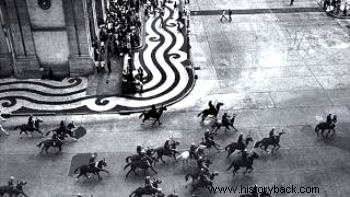Years of Lead is an expression used to designate the 70's in several countries.
This period was characterized by violent attacks promoted by the extreme left, the extreme right and police repression.
Origin

Poster for the 1981 film "The Years of Lead", by Margarethe von Trotta.
The term “lead years” was popularized with the release of the film Die Bleierne Zeit , by German director Margarethe von Trotta, in 1981.
Despite the literal translation of the title into Portuguese being “Os Tempos de Lead”, in Italy, the film became known as Anni di piombo – Years of lead. This seemed like a more adequate adaptation to Portuguese and the film was released in Brazil under the name of “Os Anos de Chumbo”.
In turn, the director took this title from a verse by the German Romantic poet Friedrich Hölderlin.
The film tells the story of two German sisters, raised in West Germany, who move away from their parents' strict upbringing and discover freedom through political engagement.
One becomes a member of the left-wing Red Army Fraction (Baader-Meinhof Group). On the other hand, another finds in journalism a way to fight for a better world.
The expression was perfect to describe the situation that some countries were going through at that time. After all, “lead” can refer to something heavy and difficult to bear, as it can refer to revolver bullets and machine guns.
In Brazil, we use the term “years of lead” to describe a specific period of the military regime. Likewise, countries like Argentina, Germany and Italy also use the expression to describe their history in the 1970s.
Read more about the 70s.
Years of Lead in Brazil

In Candelária, the Police Cavalry attacks the participants of the 7th day Mass of Édson Luís, killed while participating in a demonstration. Author:Evandro Teixeira, Jornal do Brasil, Rio de Janeiro, 1968.
In Brazil, there are historians who use the term to refer to the period of the military dictatorship as a whole.
Other scholars, however, use the expression only to designate the years from the promulgation of the AI-5 to the end of the Medici government (1974). At this time, the actions of leftist organizations became more violent and the government's response also became more repressive.
Learn more about the Military Dictatorship in Brazil.
Episodes such as the Guerrilha do Araguaia, kidnappings of diplomats, bank robberies and the subsequent repression that followed made police repression increasingly heavy in Brazil.
In this way, "years of lead" became popular among historiography that sought to explain what happened in those years of dictatorship.
See also:Operation CondorRead more:
- Guerrilha do Araguaia
- Institutional Act Number 5
- Emílio Medici
- What is dictatorship?
- Economic Miracle
- Questions about the Military Dictatorship
